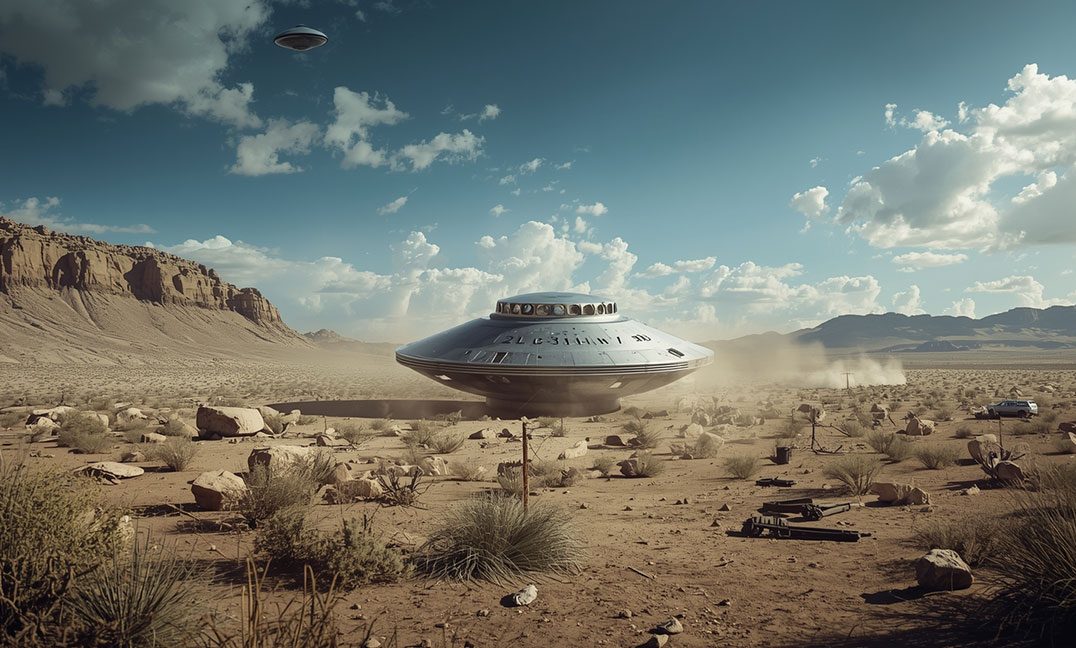
The alleged 1948 UFO crash near Aztec, New Mexico has long lingered on the edges of UFO history, overshadowed by the far more famous Roswell incident but refusing to fade entirely from public curiosity. In a recent deep-dive video, YouTube creator UAP Gerb reopens the case with a careful look at its origins, controversies, and renewed interest. His video, The 1948 Aztec, New Mexico UFO Crash Retrieval, offers an engaging re-examination of a story that has swung for decades between sensational claim and dismissed hoax. The video can be viewed here:
The core of the Aztec narrative began when journalist Frank Scully published articles in 1949 and later a book in 1950 describing a massive, nearly 100-foot-wide saucer that had supposedly landed rather than violently crashed in the desert outside Aztec. Scully reported that military and scientific personnel recovered the craft along with several small humanoid bodies. The story immediately captured public imagination, presenting itself as one of the most spectacular extraterrestrial retrieval claims of its era. Yet as quickly as it grew, the story just as rapidly imploded when investigators linked Scully’s sources—Silas Newton and Leo Gebauer—to fraudulent schemes involving purported alien technology. By the early 1950s, the Aztec case had been officially and publicly dismissed as a hoax.
Despite this early debunking, interest in the Aztec incident resurfaced decades later when UFO researchers revisited the case with a new set of questions. Authors such as William Steinman and others in the 1980s and 1990s attempted to reconstruct the events using witness interviews, regional history, and oral testimony, suggesting that something more complex might have occurred in 1948 than previously acknowledged. This revival reintroduced the Aztec story into UFO-research circles, where it became a contentious but persistent chapter in crash-retrieval lore.
In his video, UAP Gerb approaches the topic with a wide-angle lens, examining both the original claims and the skeptical rebuttals while avoiding the pitfalls of sensationalism. He reviews the documented timeline of events, the involvement of Newton and Gebauer, and the contradictory witness statements that have accumulated over the years. Gerb also explores the broader cultural and political environment of the late 1940s—a period marked by Cold War secrecy, rapid scientific development, and a growing public fascination with flying saucers. His narrative acknowledges the dramatic elements of the Aztec story while also scrutinizing its weaknesses, namely the lack of physical evidence and its entanglement with known con artists.
What makes the Aztec case compelling, even today, is how it reflects the challenges inherent in UFO research. The story offers a complicated mixture of verifiable fact, unverified testimony, documented fraud, and persistent rumor. It also highlights how difficult it can be to disentangle sincere belief from intentional deception, especially when decades pass between the alleged event and the investigations that follow. Gerb’s examination underscores this tension, presenting the Aztec incident not as confirmed truth nor as a closed-case hoax, but as a historical puzzle shaped by conflicting narratives.
Ultimately, the Aztec UFO story endures because it represents much more than a single alleged crash. It is a microcosm of the broader UFO mystery: claims of recovered craft, government secrecy, questionable sources, passionate researchers, and an audience eager to know whether humanity truly made contact in the desert sands of the American Southwest. UAP Gerb’s video does not claim to solve the Aztec case, but it does succeed in revitalizing the discussion with clarity, context, and thoughtful analysis. For anyone interested in UFO crash-retrieval folklore, his work offers a balanced and engaging entry point into one of the field’s most controversial episodes.

